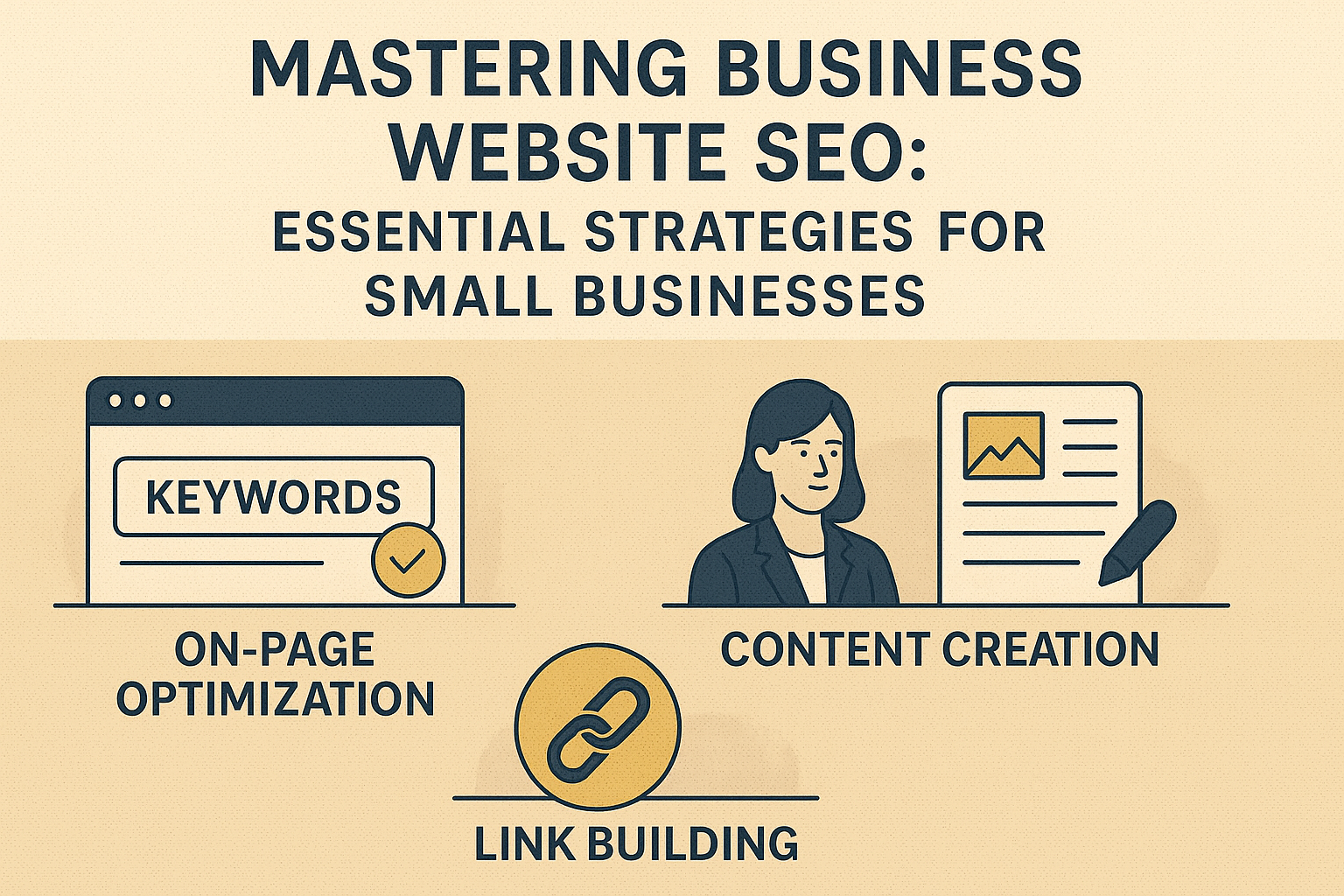In today’s digital age, having a strong online presence is crucial for small businesses aiming to stand out and grow. Mastering business website SEO can significantly impact how your site performs in search engine rankings, driving more traffic and potential customers to your business.
For small business owners and digital marketers, understanding the core SEO strategies is not just beneficial—it’s essential. This guide will walk you through effective website optimization techniques, offering practical tips to enhance your digital marketing efforts.
By focusing on these strategies, you can boost your visibility and set your business up for long-term success.
NOTE: Get Your Free Business Marketing Plan PDF Guide below.
Understanding Business Website SEO
Business website SEO is the foundation of online success for small businesses. This section will explain the importance of SEO and clarify key terms you need to know.
Importance of SEO for Small Businesses
SEO is vital for small businesses looking to compete in the digital marketplace. It helps increase visibility, attract targeted traffic, and build credibility.
By optimizing your website for search engines, you can reach potential customers actively searching for your products or services. This targeted approach often leads to higher conversion rates and better return on investment compared to traditional advertising methods.
SEO also helps level the playing field, allowing small businesses to compete with larger corporations. With a well-executed SEO strategy, even a small local business can outrank bigger competitors for relevant search terms.
Lastly, SEO builds trust and credibility. Websites that appear at the top of search results are often perceived as more trustworthy and authoritative by users.

Key SEO Terms Explained
Understanding SEO terminology is crucial for implementing effective strategies. Here are some key terms you should know:
Keywords: Words or phrases that users type into search engines to find information. Identifying and targeting the right keywords is essential for SEO success.
Backlinks: Links from other websites to your site. Quality backlinks from reputable sources can significantly boost your search engine ranking.
On-page optimization: The practice of optimizing individual web pages to rank higher and earn more relevant traffic. This includes optimizing content, HTML source code, and images.
Off-page optimization: Actions taken outside of your website to impact your rankings within search engine results pages. This primarily involves building backlinks and managing your online reputation.
SERP: Search Engine Results Page. This is the page displayed by search engines in response to a user’s query.
Effective SEO Strategies
Implementing effective SEO strategies is key to improving your website’s visibility. This section will cover essential techniques for keyword research, on-page optimization, and building quality backlinks.
Keyword Research Techniques
Keyword research is the cornerstone of any successful SEO strategy. It involves identifying the terms and phrases your target audience uses when searching for products or services like yours.
Start by brainstorming a list of topics relevant to your business. Then, use keyword research tools like Google Keyword Planner or SEMrush to expand this list and find related keywords.
Look for a mix of short-tail (1-2 words) and long-tail (3+ words) keywords. Long-tail keywords often have less competition and can be easier to rank for.
Consider search volume and competition when selecting keywords. Aim for a balance between keywords with decent search volume and manageable competition levels.
Remember to analyze your competitors’ keywords as well. This can reveal opportunities and help you identify gaps in your own keyword strategy.
On-Page Optimization Tips
On-page optimization involves optimizing individual web pages to rank higher in search results. Here are some key tips:
-
Use your target keyword in the page title, URL, and first paragraph of your content.
-
Create unique and descriptive meta descriptions for each page.
-
Use header tags (H1, H2, H3) to structure your content logically.
-
Optimize images by using descriptive file names and alt text.
Ensure your content is high-quality, relevant, and provides value to your readers. Search engines favor content that satisfies user intent.
Include internal links to other relevant pages on your site. This helps search engines understand your site structure and improves user navigation.
Lastly, make sure your website is mobile-friendly and loads quickly. These factors significantly impact your search engine rankings.
Building Quality Backlinks
Backlinks are a crucial factor in SEO, as they signal to search engines that other websites vouch for your content. Focus on quality over quantity when building backlinks.
Create valuable, shareable content that naturally attracts links. This could include original research, infographics, or comprehensive guides.
Reach out to industry influencers and relevant websites to share your content. Guest posting on reputable sites in your niche can also help build quality backlinks.
Participate in online communities and forums related to your industry. Provide helpful answers and include links to relevant content on your site when appropriate.
Be cautious of black hat SEO techniques like buying links or participating in link farms. These can result in penalties from search engines and harm your rankings.
Enhancing Website Optimization
Website optimization goes beyond just SEO. This section will cover crucial aspects like improving page load speed, ensuring mobile-friendliness, and creating quality content.
Improving Page Load Speed
Page load speed is a critical factor in both user experience and search engine rankings. Slow-loading pages can lead to high bounce rates and lower conversions.
Start by using tools like Google PageSpeed Insights to analyze your current page speed. This will provide specific recommendations for improvement.
Optimize your images by compressing them and using appropriate file formats. Large, unoptimized images are often a major cause of slow page loads.
Minimize HTTP requests by combining files where possible. For example, you can combine multiple CSS files into one.
Consider using a Content Delivery Network (CDN) to serve your content from servers closer to your users’ geographic locations.
Lastly, ensure your hosting plan is adequate for your website’s needs. A good host can significantly improve your site’s performance.
Mobile-Friendly Design Necessities
With mobile devices accounting for over half of web traffic, having a mobile-friendly website is no longer optional. It’s a necessity for good SEO and user experience.
Implement a responsive design that adapts to different screen sizes. This ensures your site looks good and functions well on all devices.
Use larger font sizes and buttons to improve readability and usability on small screens. Avoid using Flash, as it’s not supported on many mobile devices.
Optimize your site’s navigation for mobile users. Consider using a hamburger menu or other mobile-friendly navigation options.
Test your site on various devices and browsers to ensure consistent performance. Google’s Mobile-Friendly Test can help identify areas for improvement.
Remember, Google uses mobile-first indexing, meaning it primarily uses the mobile version of your site for ranking and indexing.
Crafting Quality Content
Quality content is the backbone of any successful SEO strategy. It attracts backlinks, engages users, and signals to search engines that your site is valuable.
Focus on creating content that addresses your audience’s needs and questions. Use your keyword research to identify topics your audience is interested in.
Structure your content for easy reading. Use short paragraphs, subheadings, and bullet points to break up text and improve readability.
Include a variety of content types, such as blog posts, videos, infographics, and case studies. This caters to different learning styles and keeps your content fresh.
Regularly update your content to ensure it remains accurate and relevant. This shows search engines that your site is active and current.
Always prioritize quality over quantity. It’s better to publish one well-researched, comprehensive article than several short, superficial posts.
Leveraging Digital Marketing
Digital marketing complements SEO efforts by driving traffic and engagement. This section explores how to integrate social media, email marketing, and local SEO tactics into your strategy.
Social Media Integration
Social media plays a crucial role in modern digital marketing strategies. While social signals aren’t direct ranking factors, they can indirectly boost your SEO efforts.
Choose the right platforms for your business. Focus on channels where your target audience is most active rather than trying to maintain a presence on every platform.
Share your website content on social media to drive traffic and increase visibility. This can lead to more backlinks as people discover and share your content.
Engage with your followers by responding to comments and messages promptly. This builds a community around your brand and can increase brand loyalty.
Use social media to build relationships with influencers and other businesses in your industry. These connections can lead to valuable backlink opportunities.
Remember to optimize your social media profiles with relevant keywords and links back to your website. This helps search engines understand your brand’s online presence.
Email Marketing for SEO
Email marketing and SEO might seem unrelated, but they can work together to boost your online presence and drive traffic to your website.
Use your email list to promote new content on your website. This can drive immediate traffic and potentially lead to more social shares and backlinks.
Segment your email list to deliver more targeted content. This can improve engagement rates, which in turn can lead to more website visits and lower bounce rates.
Include social sharing buttons in your emails to encourage recipients to share your content on their social networks. This can increase your content’s reach and attract new visitors.
Analyze your email marketing metrics to gain insights into what content resonates with your audience. Use these insights to inform your SEO content strategy.
Remember to always provide value in your emails. Spammy or low-quality emails can damage your brand reputation and lead to unsubscribes.
Local SEO Tactics
For businesses serving local markets, local SEO is crucial. It helps you appear in local search results and Google Maps, making it easier for nearby customers to find you.
Claim and optimize your Google My Business listing. Ensure all information is accurate and complete, including your business name, address, phone number, and hours of operation.
Encourage satisfied customers to leave reviews on Google and other relevant platforms. Positive reviews can improve your local search rankings and attract more customers.
Create location-specific pages on your website if you serve multiple areas. These pages should include relevant local content and keywords.
Ensure your NAP (Name, Address, Phone number) information is consistent across all online directories and your website. Inconsistencies can confuse search engines and harm your local SEO.
Participate in local events and create content about local topics. This can help establish your business as a part of the local community and attract local backlinks.
Monitoring Search Engine Ranking
Tracking your SEO progress is crucial for refining your strategy. This section covers using analytics tools, tracking SEO progress, and adapting to algorithm changes.
Using Analytics Tools
Analytics tools provide valuable insights into your website’s performance and user behavior. These insights can help you make data-driven decisions to improve your SEO strategy.
Google Analytics is a free, powerful tool that offers a wealth of information. It can show you where your traffic is coming from, which pages are most popular, and how users interact with your site.
Set up goals in Google Analytics to track specific actions, such as form submissions or product purchases. This helps you measure the effectiveness of your SEO efforts in driving desired outcomes.
Use Google Search Console to monitor your site’s performance in search results. It provides data on search queries, click-through rates, and any technical issues that might affect your rankings.
Consider using additional SEO tools like SEMrush or Ahrefs for more in-depth analysis. These tools can provide detailed keyword data, backlink analysis, and competitor insights.
Remember to regularly review your analytics data and use the insights to inform your SEO strategy. Data-driven decisions are key to improving your search engine rankings over time.
Tracking SEO Progress
Tracking your SEO progress helps you understand what’s working and what needs improvement. It’s an ongoing process that requires consistent monitoring and analysis.
Start by establishing baseline metrics for key performance indicators (KPIs) such as organic traffic, keyword rankings, and conversion rates. These will serve as reference points for measuring progress.
Set realistic goals based on your baseline metrics. Remember that SEO is a long-term strategy, and significant improvements often take time.
Monitor your keyword rankings regularly. Tools like Google Search Console or paid SEO software can help you track how your target keywords are performing in search results.
Keep an eye on your organic traffic trends. Look for patterns and try to correlate traffic changes with specific SEO actions or external factors.
Don’t forget to track conversions from organic traffic. While increased traffic is good, the ultimate goal is to drive actions that benefit your business.
Adapting to Algorithm Changes
Search engines regularly update their algorithms to improve search results. Staying informed and adaptable is crucial for maintaining and improving your rankings.
Stay updated on algorithm changes by following reputable SEO news sources. Websites like Search Engine Journal or Moz’s algorithm update history can provide valuable information.
When a major update occurs, monitor your rankings and traffic closely. Significant changes could indicate that the update has affected your site.
Focus on creating high-quality, user-focused content rather than trying to game the system. This approach is more likely to withstand algorithm changes in the long run.
Regularly audit your website for potential issues. This can help you identify and fix problems before they negatively impact your rankings.
Be prepared to adjust your strategy if necessary. SEO is an evolving field, and flexibility is key to long-term success.




